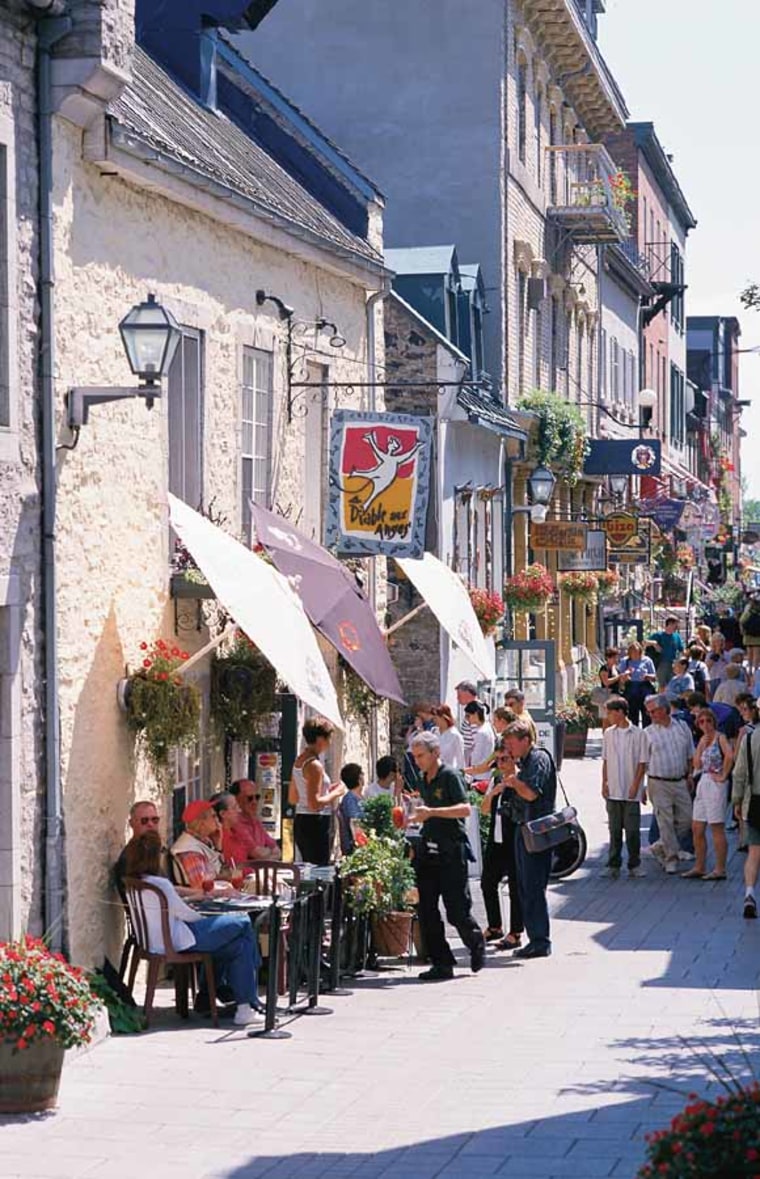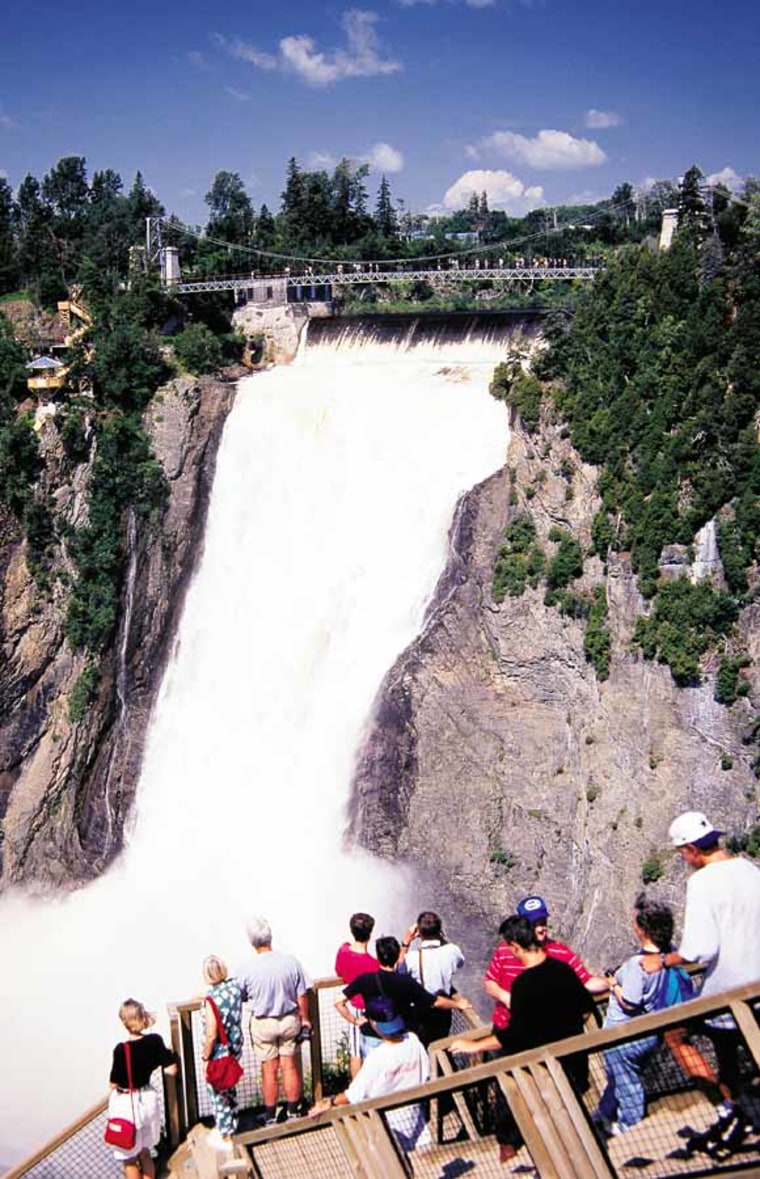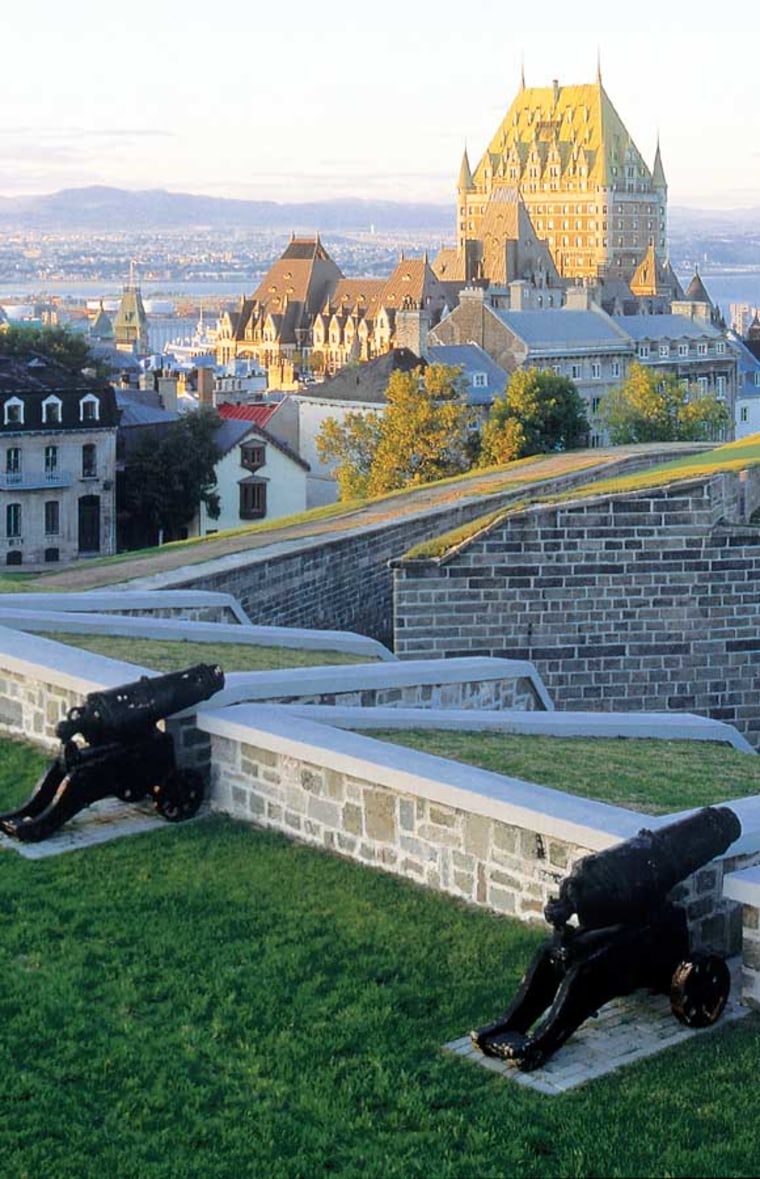Most visitors to this Canadian city known for a European ambience head straight to Vieux Quebec—the old quarter—with its stone fortifications and four centuries of history. But arriving on a sunny summer day last year, with a cool breeze blowing off the sparkling St. Lawrence River, my family and I were drawn as much to the breathtaking scenery surrounding the city as we were to the cobblestoned streets of Vieux Quebec.
We decided to spend as much of our three-day visit as possible outdoors. In addition to the cafes, cannons and colorful streetscapes of Vieux Quebec, we took in nearby Montmorency Falls, which rise nearly 100 feet (30 meters) higher than Niagara Falls, and also spent a day on Ile d'Orleans, a jewel of an island dotted with picturesque farmhouses.
Vieux Quebec first
We started, like most visitors, in the old city, which sits 300 feet (92 meters) above the river, overlooking the lower part of town. The old city is literally walled in by stone ramparts that protected early French settlers from invasion.
The neighborhood is dominated by the massive Chateau Frontenac. Its stone turrets and gables make it look like a medieval castle, but it's actually a luxury hotel built in 1893 on the spot where, in 1620, explorer Samuel de Champlain erected a fort.

Nearby streets are jammed with cafes and open-air boutiques where artists and craftsmen sell their wares. A statue of Champlain stands near a terraced promenade that affords spectacular views of the river. But our favorite part of the old city was the outdoor performers, whose magic tricks, juggling, unicycling and general merrymaking draw crowds of all ages.
We also took a ride on the funicular, a one-car shuttle train up and down the hill where the old city is located. Below the promontory, narrow, winding streets and small stone houses decorated with brightly painted shutters and overflowing windowboxes made us feel like wanderers in some quiet Parisian arrondissement.
West of the old city, at the other end of town along the Grande Allee, lie the Plains of Abraham, a spacious and lovely urban greenspace where our kids blew off steam in the playground and a grassy field. We watched the old men play petanque, a ball-tossing game like bocci, and sat on a bench beneath a tree as the locals jogged, skated and biked around a circular path.
Quit pounding the pavements and take off to see the natural wonders (and quaint towns) right outside this historic city
Out into the countryside
Next on our itinerary: Montmorency Falls Park, or Parc de la Chute-Montmorency, located where the St. Lawrence meets the Montmorency River.
We took a cable-car ride up to the falls, which are 272 feet (83 meters) high. Then we walked back down along a roundabout but exceedingly pleasant route that afforded a different panoramic view of the noisy, rushing water with every few steps. The route included a thrilling walk across a bridge suspended over the top of the falls,

as well as wooded trails, stairs, walkways and a footbridge.
The hike down was so much fun we wished we'd walked up as well; the route is easily managed by small children and any reasonably fit adult, but wear shoes you don't mind getting wet; the ground gets splashed in places. You can buy snacks at the cable-car terminals, and there's a restaurant, Manoir Montmorency, near the top. The Manoir is also home to an interpretation center where you can see photos of the giant snow cone, known as the Sugarloaf, formed by frozen spray from the falls in winter.
Lovely Ile d'Orleans
Without a doubt, the best part of our trip was Ile d'Orleans, just a 15-minute drive from Quebec City, connected by a bridge across the St. Lawrence. The island is encircled by a roadway called Chemin Royal, and we spent a heavenly day driving the loop.
Farmers sell their produce from roadside stands all over the island. We bought succulent ripe strawberries, plums, apples and cider, and had a fruit picnic on the spot. Our next snack was equally delicious but not quite as nutritious: bonbons and ice cream at the Chocolaterie de l'Ile d'Orleans, where we pigged out while rocking in a swingseat in the store's shady backyard. As we left the island, we couldn't resist stopping at a bakery for milles-feuilles—literally translated as “a thousand leaves”—which consist of buttery dough rolled paper-thin, stuffed with cream and jam, topped with a black-and-white icing.
In addition to eateries, Ile d'Orleans is also dotted with artists' studios, historic churches and small marinas where we climbed the stone jetties that jut out into the sea. At a rustic playground, we scrambled up a watchtower for a bird's eye view of the scenery. Gardens filled with tall sunflowers nodding in the breeze reminded me of Provence. Old-fashioned farmhouses and silos, nestled amid a yellow-and-green patchwork quilt of neatly tilled fields of crops, looked like a 19th century landscape painting.
Elsewhere in the Quebec City area, the basilica at Ste. Anne de Beaupre, which contains the saint's relics, attracts a million visitors a year. Less famous but worth a visit is the nearby Musee de l'Abeille, a unique museum devoted to bees. We loved the “bee safari,” in which a beekeeper—wearing a protective uniform and mesh face-mask—forces smoke into a wood-slatted hive to rouse the bees for a demonstration. Don't worry about getting stung; guests are safely seated behind a screen.
Afterwards, we attended a honey tasting and were surprised by the distinct differences among the mild clover honey harvested in July, the fruity apple- and dandelion-honey harvested in spring, and the strong wildflower honey harvested in August.
As we headed home to the states, we felt like we'd taken a trip to a place much farther away than Canada—a place where time stopped long ago, preserving both the quaint streetscapes of a charming city and the idyllic landscapes of the rural world.
If you go
LANGUAGE: French is the official language but English is widely spoken.
ACCOMMODATIONS: Summer is peak season in Quebec City. Don't arrive without hotel reservations, and don't expect to pay much under C$135 (US$100) a night. We stayed at Hotel Clarion, 15 minutes outside the city (3125 Hochelaga Blvd., Ste. Foy, where summer weekend rates begin at 140 Canadian dollars (US$110) for a double. Rooms at Fairmont Le Chateau Frontenac (1 rue des Carrieres in Vieux Quebec, 418-692-3861) begin at C$429 (US$319) twice that for suites.
MONTMORENCY FALLS: Seven miles (11 kilometers) east of Quebec City via Autoroute 440. The park is open daily, with gondola rides (one-way tickets, C$5.75 (US$4.30); ages 6 to 16, C$3 (US$2.25); 5 and under free; from 8:30 a.m. to early evening; (418) 663-3330 or www.sepaq.com/En. Parking is C$8.25 (US$6.15).
MANOIR MONTMORENCY: Restaurant near the top of the falls. Entrees C$13 to C$21 (US$10 to US$16); Sunday brunch buffet, C$20 (US$15); (418) 663-3330.
ILE D'ORLEANS: Across the river from Quebec City via Autoroute 138; www.iledorleans.com.
CHOCOLATERIE DE L'ILE D'ORLEANS: 150 Chemin du Bout de l'Ile, Sainte-Petronille, on Ile d'Orleans; (418) 828-2252.
MUSEE DE L'ABEILLE (BEE MUSEUM): 8862 Boulevard Ste. Anne in Chateau-Richer; take Autoroute 138 East in the direction of Ste. Anne de Beaupre. Open daily 9 a.m. to 6 p.m., with bee safaris on the hour, from June 24 to Labor Day; 9 a.m. to 5 p.m. the rest of the year; www.musee-abeille.com/en/default.html or (418) 824-4411. Admission: C$3.50 (US$2.60); ages 6 to 12, C$2 (US$1.50); 5 and under free.
STE. ANNE DE BEAUPRE: Avenue Royale and Boulevard Ste. Anne (Autoroute 138); basilica open daily, 6:30 a.m. to 10 p.m.; (418) 827-3781.
QUEBEC CITY: Visit www.quebecregion.com/e/ or call (418) 641-6290.
